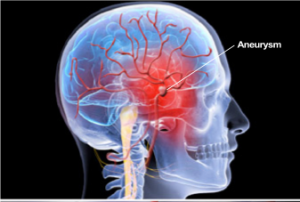Today in class Andrew discussed the condition of Brain Aneurysms. I found this topic intriguing due to the fact that my aunt has recently suffered from brain aneurysms and her situation was very similar to same predicament Andrew’s friend was in. My aunt had always been very happy and lively. She never broke her smile. But, she unfortunately decided to make the personal decision in becoming a smoker. And a very heavy one at that. Even with this factor in mind no one in my family, myself included, thought anything life-threatening could happen to such a wonderful women. But we were shockingly proven wrong. Was there a way in which my aunt could’ve avoided this life-altering incident? Or was this simply inevitable?
Null Hypothesis: Nothing can be done to avoid getting a brain aneurysm.
Alternative Hypothesis: Actions can be taken to avoid getting a brain aneurysm.
What is a brain aneurysm?
A brain aneurysm is a “bulging, weak area in the wall of an artery that supplies blood to the brain”. (WebMD) When a brain aneurysm ruptures the result is a “subarachnoid hemorrhage“. “Depending on the severity of the hemorrhage, brain damage or death may result.” (WebMD)
Where?
“The most common location for brain aneurysms is in the network of blood vessels at the base of the brain called the circle of Willis.” (WebMD)
Causes?
The correlation is present that people can inherit the tendencies of brain aneurysms, or they can occur from the due to the hardening of arteries (atherosclerosis). WebMD also states:
- Family History: People who have a family history of brain aneurysms are more likely to have an aneurysm than those who don’t.
- Previous Aneurysm: People who have had a brain aneurysm are more likely to have another.
- Gender: Women are more likely to develop a brain aneurysm or to suffer a subarachnoid hemorrhage.
- High Blood Pressure
- Smoking
Procedure?
According to Medline Plus there are two main options when it comes to removing a brain aneurysm.
- Option #1-Aneurysm Clipping: “You are given general anesthesia and a breathing tube…your scalp, skull, and the coverings of the brain are opened…A metal clip is placed at the base (neck) of the aneurysm to prevent it from breaking open (bursting).”
- Option #2-Endovascular Repair: “A catheter is guided through a small cut in your groin to an artery and then to the blood vessel in your brain where the aneurysm is located.”
Symptoms: According to WebMD “most brain aneurysms have no symptoms”. Other possibilities are:
- A sudden, severe headache that is different from past headaches.
- Neck pain.
- Nausea and vomiting.
- Sensitivity to light.
- Fainting or loss of consciousness.
- Seizures.
Now that we know the significant aspects of brain aneurysms we’re back to the important question: What can be done to prevent them? According to The Aneurysm and AVM Foundation there are two categories of prevention: things you can’t control vs. things you can control. “At this point, the only preventative measures are screening, controlling high blood pressure and eliminating smoking.”
Conclusion: Due to the results I found based on the prevention of brain aneurysms the null hypotheses can be rejected. We can all take precautions to hopes of avoiding this life-threatening condition. But unfortunately, the alternative hypothesis cannot be fully accepting. There are usually no symptoms present which would point to a brain aneurysm. Due to hereditary reasons and other third variables, which have not yet been fully explained, we cannot 100% eliminate our chances of getting a brain aneurysm. The causes which were stated by WebMD are only suggestions. The correlation is not certain. Correlation does not equal causation.
Take Home Message: Today my Aunt Helene is not the person she used to be. She is no longer able to speak and is forced to use a wheelchair. On good days she is somewhat able to write. Her recovery has been a slow but positive one, and my family continues to have hope and support for her. There are many practically harmless steps which we can all take in order to make ourselves healthier and less prone to brain aneurysms. The most impactful way to learn a lesson is to see someone you love go through something so tragic that, in the end, could have possibly been avoided. Don’t let this happen to you.



